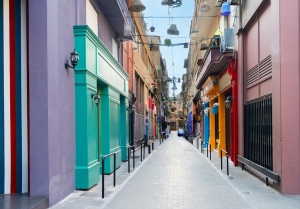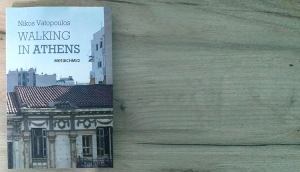BUSINESS CENTRE
XpatAthens
The Road Trip Project - An EU Travel Experience
Amoeba Trio Performs At The Ancient Roman Agora Of Athens
June 26th - Athens City Vibes
Ryanair To Add 12 New Routes From Greece
Athens Through The Pen And Lens Of Nikos Vatopoulos
Most of us already know Nikos Vatopoulos as a journalist and as the Chief Editor of Culture at Kathimerini newspaper and not as a book author. Born and bred in Athens, Vatopoulos' path to adulthood was inevitably intertwined with the city's constant development. It is his exploration and experiences of Athens that unravel in his newest book, Walking in Athens.
Published by Metaixmio, Walking in Athens is a collection of articles accompanied by stunning photos through which we will get to know Athens and its fascinating synthesis of urban elements.
It speaks about an ever-developing society, an evolving civilization, and the history of the city's communities. Walking in Athens discloses hidden urban myths and reveals the fascinating history of an entire century, right before our eyes.
To learn more about this award-winning book, please click here.
FOUGARO ARTCENTER
FOUGARO hosts live music events every Saturday night, dj sets on Fridays, and an annual Jazz Festival every September. Contemporary art exhibits run through the year, and sculptures of the FKPCOLLECTION adorn all gardens and patios. Workshops for young and old include ceramics, drawing, and painting, and an annual exhibition of its students’s works is presented every summer in all its workshop spaces.
Water features, fragrant gardens, two multilingual libraries and a towering smokestack, all combine to create a welcoming oasis of culture and aesthetics, making FOUGARO ARTCENTER the ideal place to relax, savour and enjoy life!
Dentist-Pass For Children To Be Launched
Goal of the Health Ministry is that starting from March 2023 parents will be able to book an appointment with a dentist of their choice simply using the new Dentist Pass voucher.
Dentists who wish to participate in this new service network will be able to participate, provided they have a registered POS.
The program Dentist-Pass includes a visit to the dentist and thus for the following services:
- Control of the child’s oral hygiene
- Dental fluoridation
- Cleaning Oral hygiene information and instructions for children and parents
One of the two parents submits an application for the issuance of the financing card through gov.gr or through the KEPs on the Program’s Electronic Platform.
The card will then be stored in the digital wallet of the beneficiary parent’s mobile phone and can be used at the POS of all dental offices.
Each voucher that will be activated will be valid for six months.
The Dentist Pass voucher is reportedly set to cover 600,000 children aged 6 to 12.
Originally published on: keeptalkinggreece.com
Elpida Trizi - Communication & Embodied Leadership Coach
You can find me here: Wonder Works

2025: Certified Somatic Coach by Strozzi Institute (SISC)
2023: Embodied Transformation by Strozzi Institute
2023: Organization and Relationship Systems Coaching (ORSC) Fundamentals
2022: Associate Certified Coach (ACC) by the International Coaching Federation (ICF)
2022: Certified Professional Coactive Coach (CPCC) by the Co-Active Training Institute (CTI)
2021-2022: The Neuroscience of Change “Understand the Brain – Transform your Coaching”, an online coach training by Coaches Rising
2020: Positive Intelligence: Online coaching learning journey and mental fitness program by Shirzad Chamine
2019-2020: Co-Active Coach Training Fundamentals and Intermediate by the Co-Active Training Institute (CTI)
2006: Reiki Level I practitioner
1996: MA in Image Studies from the University of Canterbury, UK
1994: BSc in Communication & Mass Media from the National & Kapodistrian University of Athens, Greece
Get in touch with me here: Wonder Works
Greece’s Health & Wellness Spas
Well-being does not concern physical health only. It is a general feeling, an internal ray of health, force and beauty. It is an on-going process. The successful endeavor by anyone for a better life, the coverage of internal desires, his particularities, the freedom to choose comprise his personal recipe for well-being. I feel good, I’m having a good time, means that I am feeling mentally well-balanced and I feel healthy.
Because if health –in accordance with the definition prescribed in the constitution of the World Health Organization (1946) – is “a state of complete physical, mental and social well-being and not just the absence of an illness or a disability”, a person can easily understand that the meaning of health is not given only by medicine, but also by other factors such as environment, economy, work, etc, and is based solely on a feeling of well-being.
Apart from the rare landscapes and special natural beauties, nature also endowed Greece with springs with important therapeutic properties. Spas are part of the country’s national wealth, while their therapeutic properties were already known in ancient times.
Natural therapeutic springs are found in many different places in Greece, and the water from specific springs differs from ordinary water owing either to its high temperature, or to the presence of rare active components.
Greece is one of the richest countries in the world in terms of natural spas. Thermal and mineral springs appear at 850 different geographical locations.
In addition to revitalising the spirit, the large number of mineral springs in Greece offers visitors an opportunity to receive treatment for chronic conditions in a natural way (hydrotherapy). Ailments like arthritis and rheumatic disorders are traditionally associated with the elderly, and therefore everyone believes that spas are for the “therapeutic” treatment of mainly senior citizens. However, the beneficial properties are much broader as they also benefit people of all ages. They start by improving appearance (concerns mainly the condition of the skin) and arrive at the more generalized feeling of relaxation and well-being.
The development of health and spa tourism in Greece has been rapid and there is to observe a significant growth of supply and service differentiation. The forms of hydrotherapy treatment applied in Greece are spa or mud therapy, drinking or inhalation therapy.
Fourteen hydro-therapeutic centres (owned by G.N.T.O.) annually treat around 100,000 persons, with 1,400,000 therapeutic treatments, while dozens of other spas operated by local authorities offer modern high-quality services to visitors. In addition, spa centers with state of the art facilities and specialized staff can be found in the majority of the five-star hotels, while other spas can usually be found in Athens or Thessaloniki.
Moreover, thalassotherapy is used as a combination of relaxation, revitalisation, recreation and healing that is achieved in the ideal climatic conditions of Greece and with the use of its excellent seawater. Natural resources are still in use but a holistic provision of body and soul is being introduced including wide spectrum of fitness and wellness products and services.
With one of the best climates in the world, with a unique variety of nature, as well as one of the healthiest diets in the world, Greece is the ideal proposal for psychological and physical health and the search for well-being!
Source:Visitgreece.gr
ADEDY Announces Work Stoppage & Demonstration Noon Today
The public sector trade union ADEDY has announced a walk and demonstration for Wednesday, demanding that dismissed employees be reinstated in the posts, that the suspension legislation be abolished and that the public institutions and services that were abolished as a result are allowed to operate again.
As such, ADEDY has called for public sector employees to participate en masse in the panattic walk out, which come into effect at noon and last until the end of the day. A demonstration will also take place at 1pm at Klafthmonos Square, followed by a march to Parliament and the Ministry of Administrative Reform.
University employees join walk out
The administrative employees of the universities have also announced that they will join ADEDY’s protest, in opposition to the suspension measure which has had a profound effect on their sector.
To read more, please visit tovima.gr/en











